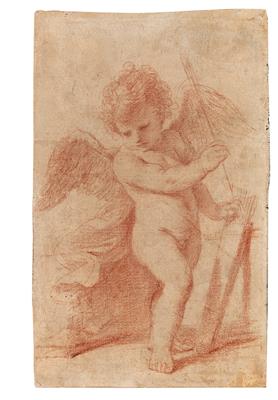Giovanni Francesco Barbieri, called Il Guercino

(Cento 1591–1666 Bologna)
Cupid putting an arrow away in his quiver, red chalk on laid paper, laid down on canvas, 24,7 x 15,3 cm, mounted, framed, (Sch)
Provenance:
Collection Anne Gore;
Private collection, Herefordshire.
With the copy of a certifcate by Dr. Nicholas Turner (of 9th of April, 2020).
Cupid or Amor (as in Latin), the winged god of love and desire, is putting the arrow into his quiver by performing an elegant twist with his body and turning the head downwards to the left. In the drawing the bow is not visible in an immediate distance which may allude to an enforced interruption of his mischievous play. Cupid is known for making men and/or gods love each other when shooting his arrows at them. Cupid induced disorder and chaos and therefore Gods wanted to break his power by stealing, breaking or burning his arrows. While Diana and Minerva condemned the mischief of his activities Cupid’s mother Venus seeked retribution for the prank he played on her and her lover Mars. The disarmament of Cupid continued to be a popular motif in the arts from the Renaissance onwards to later centuries.
Stylistic features of the present drawing speak for an execution between 1642 and the artist’s death in 1666, when Guercino stayed in Bologna. Although one cannot find direct connections of the present study with compositions from that time, one may detect numerous formal and iconographic parallels which go along with two paintings depicting full-length figures of Cupid. One picture, Cupid spurning Riches (1654), is kept in the Museo del Prado (oil on canvas, 99 x 75 cm; L. Salerino, I Dipinti del Guercino, Rome 1988, No. 303; N. Turner, The Paintings of Guercino. A Revised and Expanded Catalogue raisonné, Rome 2017, No. 423) and shows Cupid in a comparable posture as in the drawing and with similar attributes. In the Prado painting Cupid is represented as the winged god of love, looking downwards and holding the right arm before his body emptying his purse from coins. Thus, the painting alludes less to Cupid’s power over love and its inherent problems, but rather expresses the God‘s disdain for money. The other painting, Cupid burning his arrows, which is kept in a private collection, was executed in the year of Guercino’s death in 1666. (oil on canvas, 106 x 84 cm; Turner 2017, No. 502). The motif of this painting can be related to the one of the present drawing. It shows Cupid in a similar posture with lowered head but without wings and holding the last of his arrows in his hand after having thrown the others together with the bow and the quiver into the fire. Due to stylistic features Turner dated the sheet and the painting to 1666, despite the fact that there is no evidence that the two works are connected with each other.
Around 1700 many drawings by Guercino and by his two nephews Benedetto und Cesare Gennari were framed and kept in the Casa Gennari in the centre of Bologna and in the country house of the Bel Poggio family. The majority of the framed drawings were mounted on canvas rather than on cardboard which was customary with drawings in the 18th century and which applies also to the present sheet. The majority of drawings by Guercino and his school in the Royal Library in Windsor Castle and in the possession of the Gennari-family are laid down on canvas. Therefore one cannot exclude that the present sheet may have the same provenance.
Specialist: Mag. Astrid-Christina Schierz
 Mag. Astrid-Christina Schierz
Mag. Astrid-Christina Schierz
+43-1-515 60-546
astrid.schierz@dorotheum.at
20.10.2020 - 15:33
- Realized price: **
-
EUR 8,960.-
- Starting bid:
-
EUR 6,000.-
Giovanni Francesco Barbieri, called Il Guercino
(Cento 1591–1666 Bologna)
Cupid putting an arrow away in his quiver, red chalk on laid paper, laid down on canvas, 24,7 x 15,3 cm, mounted, framed, (Sch)
Provenance:
Collection Anne Gore;
Private collection, Herefordshire.
With the copy of a certifcate by Dr. Nicholas Turner (of 9th of April, 2020).
Cupid or Amor (as in Latin), the winged god of love and desire, is putting the arrow into his quiver by performing an elegant twist with his body and turning the head downwards to the left. In the drawing the bow is not visible in an immediate distance which may allude to an enforced interruption of his mischievous play. Cupid is known for making men and/or gods love each other when shooting his arrows at them. Cupid induced disorder and chaos and therefore Gods wanted to break his power by stealing, breaking or burning his arrows. While Diana and Minerva condemned the mischief of his activities Cupid’s mother Venus seeked retribution for the prank he played on her and her lover Mars. The disarmament of Cupid continued to be a popular motif in the arts from the Renaissance onwards to later centuries.
Stylistic features of the present drawing speak for an execution between 1642 and the artist’s death in 1666, when Guercino stayed in Bologna. Although one cannot find direct connections of the present study with compositions from that time, one may detect numerous formal and iconographic parallels which go along with two paintings depicting full-length figures of Cupid. One picture, Cupid spurning Riches (1654), is kept in the Museo del Prado (oil on canvas, 99 x 75 cm; L. Salerino, I Dipinti del Guercino, Rome 1988, No. 303; N. Turner, The Paintings of Guercino. A Revised and Expanded Catalogue raisonné, Rome 2017, No. 423) and shows Cupid in a comparable posture as in the drawing and with similar attributes. In the Prado painting Cupid is represented as the winged god of love, looking downwards and holding the right arm before his body emptying his purse from coins. Thus, the painting alludes less to Cupid’s power over love and its inherent problems, but rather expresses the God‘s disdain for money. The other painting, Cupid burning his arrows, which is kept in a private collection, was executed in the year of Guercino’s death in 1666. (oil on canvas, 106 x 84 cm; Turner 2017, No. 502). The motif of this painting can be related to the one of the present drawing. It shows Cupid in a similar posture with lowered head but without wings and holding the last of his arrows in his hand after having thrown the others together with the bow and the quiver into the fire. Due to stylistic features Turner dated the sheet and the painting to 1666, despite the fact that there is no evidence that the two works are connected with each other.
Around 1700 many drawings by Guercino and by his two nephews Benedetto und Cesare Gennari were framed and kept in the Casa Gennari in the centre of Bologna and in the country house of the Bel Poggio family. The majority of the framed drawings were mounted on canvas rather than on cardboard which was customary with drawings in the 18th century and which applies also to the present sheet. The majority of drawings by Guercino and his school in the Royal Library in Windsor Castle and in the possession of the Gennari-family are laid down on canvas. Therefore one cannot exclude that the present sheet may have the same provenance.
Specialist: Mag. Astrid-Christina Schierz
 Mag. Astrid-Christina Schierz
Mag. Astrid-Christina Schierz
+43-1-515 60-546
astrid.schierz@dorotheum.at
|
Buyers hotline
Mon.-Fri.: 10.00am - 5.00pm
kundendienst@dorotheum.at +43 1 515 60 200 |
| Auction: | Master Drawings, Prints before 1900, Watercolours, Miniatures |
| Auction type: | Online auction |
| Date: | 20.10.2020 - 15:33 |
| Location: | Vienna | Palais Dorotheum |
| Exhibition: | 14.10.2020 - 20.10.2020 |
** Purchase price incl. charges and taxes
It is not possible to turn in online buying orders anymore. The auction is in preparation or has been executed already.
